Figures & data
Table I. Summary of the 195 loggerhead and green turtles tracked by satellite in the Mediterranean (data presented in published papers, up to 2013).
Figure 1. General migratory routes of the 63 adult loggerhead turtles satellite tracked in the Mediterranean () and showing type A movement pattern (Godley et al. Citation2008). Only groups of ≥ 10 animals released from the same site are considered, while releases of single individuals () are not shown. Arrows represent the approximate, general courses and do not show the actual reconstructed routes. Circles represent the release breeding sites in Greece (32 females and 23 males) and Cyprus (eight females; two turtles remained along the Cyprus coast). Number of individual females (F) and males (M) reaching different destinations are shown in boxes. The 200 m isobath is shown. AL, Albania; BA, Bosnia and Herzegovina; CY, Cyprus; EG, Egypt; GR, Greece; HR, Croatia; IL, Israel; IT, Italy; LB, Lebanon; LY, Libya; ME, Montenegro; SI, Slovenia; SY, Syria; TN, Tunisia; TR, Turkey.
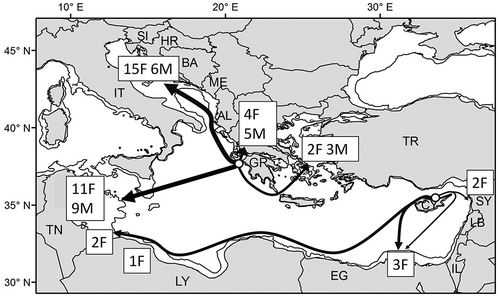
Figure 2. Seasonal migrations in Mediterranean loggerheads. Blue track: migration of a rehabilitated juvenile turtle that left the release site in the North Adriatic (blue dot) in autumn 2007, remained in the Ionian Sea during winter and early spring and returned to northern Adriatic in May 2008 (from Casale et al. Citation2012a). Red track: seasonal migration of an adult female that moved to the northern Adriatic after completing nesting in Zakynthos island (red dot) and then migrated south during winter (from Zbinden et al. Citation2008). Arrows indicate direction of movement. The 200 m isobath is shown. AL, Albania; BA, Bosnia and Herzegovina; GR, Greece; HR, Croatia; IT, Italy; ME, Montenegro; SI, Slovenia. (Note: the colour version of this Figure is available only in the online edition of this journal).
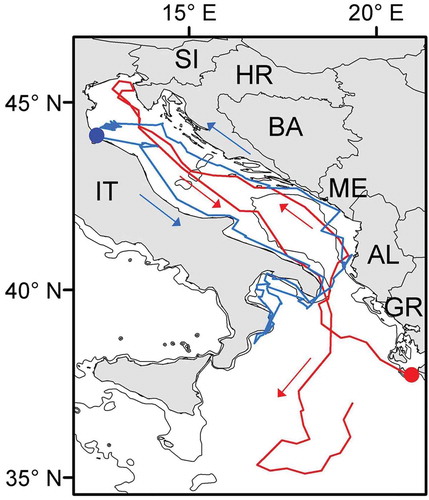
Figure 3. Examples of variable movements in juvenile loggerheads in the Mediterranean. Turtles released from southwestern Italy performed long-distance erratic movements over large oceanic areas (brown, orange and green tracks; Hochscheid et al. Citation2010). Conversely, turtles released from the Tunisian (fuchsia and dark blue; Casale et al. Citation2012b) and Adriatic shelves (red and light blue; Casale et al. Citation2012a) displayed convoluted movement over more restricted areas. Release sites are indicated by open circles. The 200 m isobath is shown. AL, Albania; BA, Bosnia and Herzegovina; DZ, Algeria; GR, Greece; HR, Croatia; IT, Italy; ME, Montenegro; SI, Slovenia; TN, Tunisia. (Note: the colour version of this Figure is available only in the online edition of this journal).
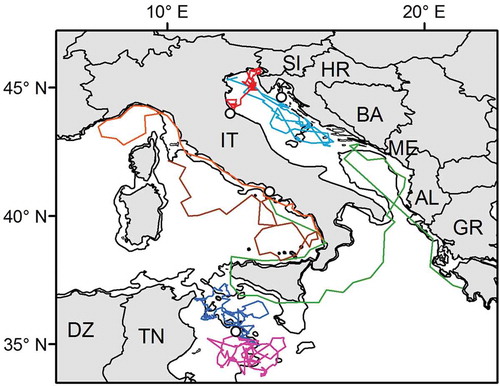
Figure 4. Schematic examples of the areas frequented by satellite-tracked juvenile loggerheads in the Mediterranean. All turtles considered were tracked for a minimum of 120 days. The areas frequented by juveniles in the oceanic zone north of Algeria (a; Revelles et al. Citation2007b; Cardona et al. Citation2009) tend to be larger than areas of juveniles in the neritic zones along the Spanish coast (b; Cardona et al. Citation2009), the Tunisian (c; Casale et al. Citation2012b) and Adriatic shelves (d; Casale et al. Citation2012a), and the western Italian coast (e; the arrows indicate the areas frequented by two turtles; Mencacci et al. Citation2011). The 200 m isobath is shown. AL, Albania; BA, Bosnia and Herzegovina; DZ, Algeria; FR, France; GR, Greece; HR, Croatia; IT, Italy; LY, Libya; MA, Morocco; ME, Montenegro; SI, Slovenia; SP, Spain; TN, Tunisia.
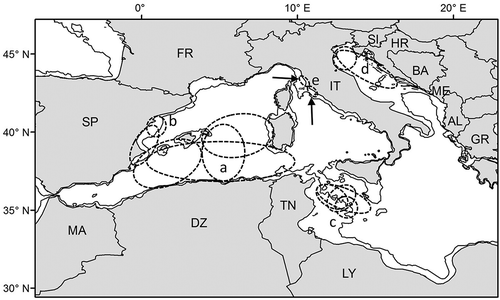
Figure 5. Specific cases of distribution and movements of loggerhead turtles in the Mediterranean. The main movement routes and the areas possibly visited by Atlantic individuals entering the Mediterranean are shown by grey arrows. Black arrows indicate the course of the possible seasonal movements from the two northernmost and coldest areas of the Mediterranean, the Ligurian Sea (a; only juveniles) and the north Adriatic (b; both adults and juveniles). The 200 m isobath is shown. AL, Albania; BA, Bosnia and Herzegovina; DZ, Algeria; FR, France; GR, Greece; HR, Croatia; IT, Italy; LY, Libya; MA, Morocco; ME, Montenegro; SI, Slovenia; SP, Spain; TN, Tunisia.
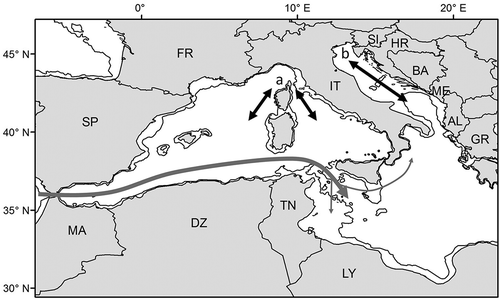
Figure 6. Migratory routes of 13 adult green turtles satellite tracked in the Mediterranean (). Arrows represent the approximate, general courses and do not show the actual reconstructed courses. Routes of females and male are represented by black and grey lines respectively. Circles indicate the release sites of 10 females and one male (Cyprus), two females (Turkey) and one female (Syria). The area of Turkey, Syria and Cyprus is shown enlarged in the top right box. Number of individual females (F) and males (M) reaching different destinations are shown in boxes. The 200 m isobath is shown. AL, Albania; BA, Bosnia and Herzegovina; CY, Cyprus; EG, Egypt; GR, Greece; HR, Croatia; IL, Israel; IT, Italy; LB, Lebanon; LY, Libya; ME, Montenegro; SI, Slovenia; SY, Syria; TN, Tunisia; TR, Turkey.

